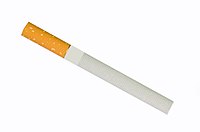
Comparing two approaches to remote biochemical verification of self-reported cessation in very low-income smokers
Sign Up to like & getrecommendations! Published in 2021 at "Addictive Behaviors Reports"
DOI: 10.1016/j.abrep.2021.100343
Abstract: Highlights • Low-income smokers preferred urine tests over breath tests to confirm cessation.• Rates of completing in-home urine tests were comparable to rates in prior studies.• Many digital photos of urine test results were inconclusive,… read more here.
Keywords: comparing two; urine tests; income smokers; cessation ... See more keywords

Income as a moderator of psychological stress and nicotine dependence among adult smokers.
Sign Up to like & getrecommendations! Published in 2018 at "Addictive behaviors"
DOI: 10.1016/j.addbeh.2018.04.021
Abstract: BACKGROUND Perceived stress and psychological distress are associated with more cigarette craving and withdrawal, higher nicotine dependence, and less success during quit attempts. Low income smokers have disproportionately higher rates of smoking and may be… read more here.
Keywords: dependence; income; nicotine dependence; income smokers ... See more keywords

A Pilot Study and Ecological Model of Smoking Cues to Inform Mobile Health Strategies for Quitting Among Low-Income Smokers.
Sign Up to like & getrecommendations! Published in 2020 at "Health promotion practice"
DOI: 10.1177/1524839920942214
Abstract: One crucial factor that leads to disparities in smoking cessation between groups with higher and lower socioeconomic status is more prevalent socioenvironmental smoking cues in low-income communities. Little is known about how these cues influence… read more here.
Keywords: ecological model; income smokers; low income; health ... See more keywords

Responses to Graphic Warning Labels among Low-income Smokers.
Sign Up to like & getrecommendations! Published in 2020 at "American journal of health behavior"
DOI: 10.5993/ajhb.44.5.5
Abstract: Objective: Graphic warning labels (GWLs) are effective in communicating tobacco-related harms. Methods: In this mixed-methods study, we used purposive sampling to recruit 100 low-income smokers in the San Francisco Bay Area between October 2017 and… read more here.
Keywords: among low; warning labels; income smokers; low income ... See more keywords